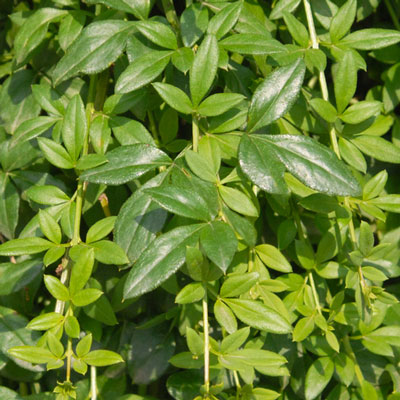Winter Jasmine: Dependable, Uncommon – by Steve Huddleston
Winter jasmine is a tough, not-so-common shrub that is perfectly suited for Texas and one that adds cool-season interest to the landscape.
Although it can be trained as a vine to 10 to 15 ft. tall, it’s usually grown as a mounding shrub 3 to 4 ft. tall and 4 to 6 ft. wide. It produces many stems from a central crown. They arch to the ground where they can develop roots to form a dense mat.

Each stem of winter jasmine is square, and each remains green through the winter. As a result, the shrub appears to be evergreen even after the leaves have all dropped in the fall.

The compound leaves are made up of three leaflets each, each leaflet being medium green in color and 1 to 1-1/2 in. in length. There is no significant fall color.
Before the leaves emerge in spring solitary yellow flowers are borne along the arching branches. The blooms resemble those of forsythias. However, winter jasmine plants bloom sporadically along their stems compared to the profusion of yellow blooms you’ll see on forsythias a few weeks later. Nonetheless, those yellow blossoms in the winter landscape are a welcome sight when few other plants are blooming.

What you should know…
• Common name: Winter jasmine
• Scientific name: Jasminum nudiflorum (meaning flowers come before leaves)
• Plant family: Oleaceae, or olive family
• USDA Plant Hardiness Zones: 6-10 (all of Texas)
• Native home: Northern China
• Bloom time: late January into early March
• Landscape height, width: Usually kept at 30-40 in., but can grow taller, wider.
• Sun or shade: Very adaptable
• Soil preference: Any deep soil type, ideally with generous amounts of organic matter.
• Moisture needs: Does best with consistently moist soils. Once established, somewhat drought resistant.
• Pruning: As needed to maintain desired form but wait until flowering time has passed. Can be cut back hard (to 18 to 24 in.)

Best landscape uses:
• Massed in embankment plantings,
• Tall groundcover on slopes,
• Atop a retaining wall to help soften look of the wall,
• As small clusters in front of taller shrubs just for visual changes.
• Grown as a vine planted against a support on the south side of a building so it will receive full winter sun.
• How propagated: Cuttings or by digging offsets when stems have rooted after making contact with soil.
Note: You may need to start your own winter jasmine as plants are not commonly seen in nurseries in the United States. Browse online, however, and you’ll get the feeling that it’s all over Great Britain.

